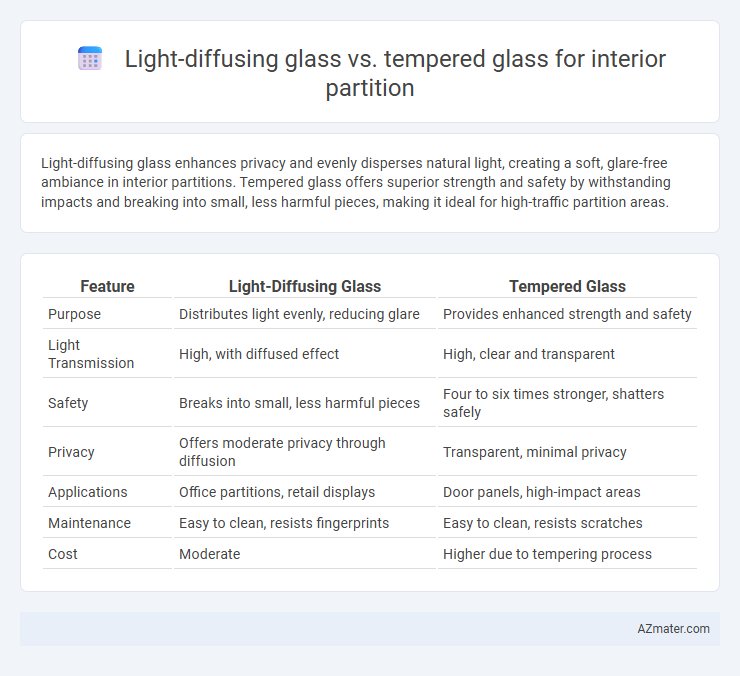Light-diffusing glass enhances privacy and evenly disperses natural light, creating a soft, glare-free ambiance in interior partitions. Tempered glass offers superior strength and safety by withstanding impacts and breaking into small, less harmful pieces, making it ideal for high-traffic partition areas.
Table of Comparison
| Feature | Light-Diffusing Glass | Tempered Glass |
|---|---|---|
| Purpose | Distributes light evenly, reducing glare | Provides enhanced strength and safety |
| Light Transmission | High, with diffused effect | High, clear and transparent |
| Safety | Breaks into small, less harmful pieces | Four to six times stronger, shatters safely |
| Privacy | Offers moderate privacy through diffusion | Transparent, minimal privacy |
| Applications | Office partitions, retail displays | Door panels, high-impact areas |
| Maintenance | Easy to clean, resists fingerprints | Easy to clean, resists scratches |
| Cost | Moderate | Higher due to tempering process |
Introduction to Glass Types for Interior Partitions
Light-diffusing glass enhances interior partitions by evenly dispersing natural or artificial light, creating a soft, glare-free ambiance ideal for offices and residential spaces. Tempered glass offers superior strength and safety, resisting impact and shattering into small, blunt pieces, making it suitable for high-traffic areas and safety-conscious installations. Understanding these glass types aids in selecting materials that balance aesthetics, functionality, and safety in interior partition design.
What is Light-Diffusing Glass?
Light-diffusing glass is designed to scatter light evenly, reducing glare and creating a soft, uniform illumination throughout interior partitions. Unlike tempered glass, which is primarily chosen for its strength and safety properties, light-diffusing glass enhances privacy while maintaining brightness by obscuring clear vision through the glass. This makes light-diffusing glass ideal for office spaces and residential interiors where both natural light diffusion and visual separation are desired.
Understanding Tempered Glass
Tempered glass, also known as toughened glass, undergoes a controlled thermal or chemical treatment process to increase its strength compared to ordinary glass, making it an ideal choice for interior partitions requiring enhanced safety and durability. This type of glass breaks into small granular chunks rather than sharp shards, reducing injury risks in case of breakage, and offers excellent resistance to thermal stress, impact, and bending forces. Unlike light-diffusing glass that scatters light for privacy, tempered glass maintains clear transparency while providing superior structural integrity and compliance with building safety codes.
Light Transmission and Diffusion Comparison
Light-diffusing glass offers superior light transmission by scattering incoming light to create an even, soft glow that reduces glare and harsh shadows, ideal for interior partitions requiring uniform illumination. Tempered glass provides high light clarity with minimal diffusion, maintaining transparency while enhancing safety through increased strength and shatter resistance. For applications prioritizing balanced natural light diffusion and privacy, light-diffusing glass outperforms tempered glass, which is better suited where clear visibility and strength are paramount.
Safety and Durability: Which is Superior?
Light-diffusing glass enhances interior partitions by distributing natural or artificial light evenly, reducing glare while maintaining privacy, and typically features a more delicate surface prone to scratches and chips compared to tempered glass. Tempered glass undergoes a heat treatment process that significantly increases its strength and safety, shattering into small, blunt pieces rather than sharp shards upon impact, which greatly reduces injury risk. For interior partitions where safety and long-term durability are paramount, tempered glass offers superior performance due to its enhanced resistance to breakage, impact, and thermal stress.
Design Versatility and Aesthetic Options
Light-diffusing glass enhances interior partitions by evenly scattering natural or artificial light, creating a soft, glowing ambiance that elevates spatial aesthetics and privacy without sacrificing brightness. Tempered glass offers superior strength and safety with a sleek, transparent finish, allowing for bold, crisp design lines and maximal visibility in modern interiors. Both materials provide design versatility: light-diffusing glass excels in adding texture and subtle visual interest, while tempered glass supports minimalist and industrial design schemes with its clean, smooth surface.
Privacy Levels: Light-Diffusing vs Tempered Glass
Light-diffusing glass offers superior privacy by dispersing light to obscure visibility while maintaining brightness, ideal for confidential spaces in offices or homes. Tempered glass, although stronger and safer due to its shatter-resistant properties, provides minimal privacy as it is typically clear and transparent. For interior partitions requiring both light transmission and privacy, light-diffusing glass is the optimal choice compared to the clear nature of tempered glass.
Installation and Maintenance Considerations
Light-diffusing glass for interior partitions requires careful handling during installation due to its delicate surface designed to scatter light evenly, often necessitating professional expertise to avoid damage. Tempered glass offers higher durability and safety, allowing for faster installation and lower maintenance since it resists scratches and impacts more effectively. Maintenance for light-diffusing glass involves regular gentle cleaning to preserve its optical properties, whereas tempered glass requires standard cleaning methods and less frequent repairs.
Cost Comparison and Value Analysis
Light-diffusing glass typically costs 20-30% more than standard tempered glass due to its specialized manufacturing process that enhances privacy and aesthetics in interior partitions. Tempered glass offers superior strength and safety at a lower price point, making it a cost-effective option for high-traffic areas. Investing in light-diffusing glass adds value by improving ambient lighting and visual comfort, justifying the higher upfront cost through increased occupant satisfaction and design flexibility.
Choosing the Right Glass for Your Interior Partition
Light-diffusing glass enhances privacy and softens natural light, making it ideal for creating serene, well-lit spaces in interior partitions. Tempered glass offers superior strength and safety, resistant to breakage and thermal stress, suitable for high-traffic areas requiring durability. Selecting the right glass depends on balancing aesthetic needs with functional demands, such as privacy, safety, and light transmission, tailored to the specific interior environment.

Infographic: Light-diffusing glass vs Tempered glass for Interior partition
 azmater.com
azmater.com